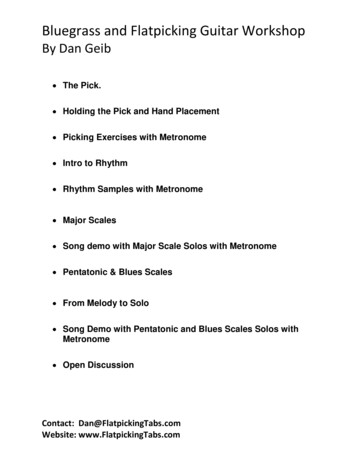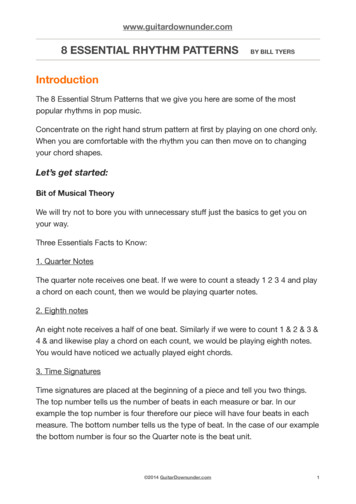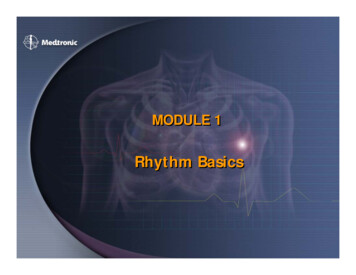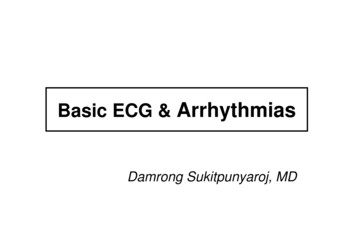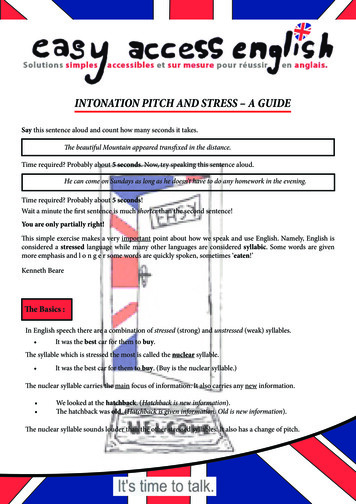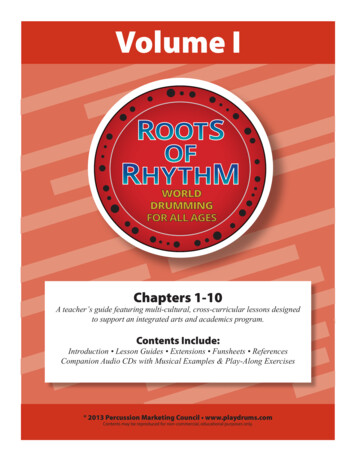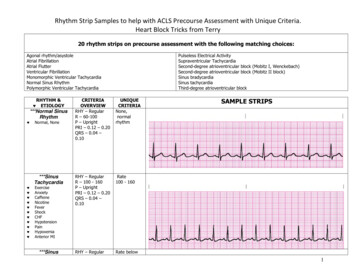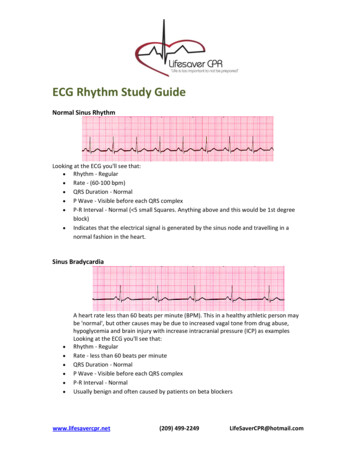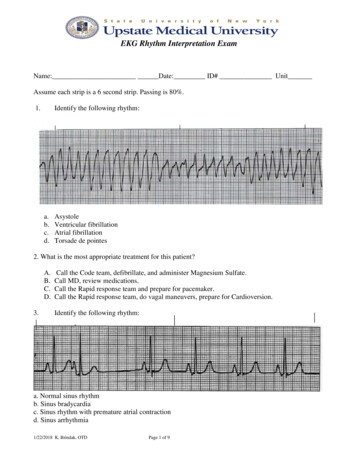
Transcription
Stress, Rhythm, ToneAnd IntonationChing Kang LiuNational Taipei u.tw/ ckliu/1
OverviewRhythm & intonation1. Rhythm (suprasegmental stress patterns) (time)a. The relationship between stressed and unstressed syllablesb. Patterns of combination of stressed and unstressed syllablesc. The liaison or other phonological structures (assimilation,deletion, etc.)2. Intonation (suprasegmental melody) (time space)a. Pitch contours; break indexes (time)b. The intonation units; the pitch accent (time space)3. Declination (suprasegmental melody) (time space)a. Declination of statements (time space)b. Down-step slopes (time space)2
ContentsWhat are different between the two languages?1. Stress & rhythm2. Intonation units3. Pitch accents(The invariable quality of the stressed syllable/sound)4. The break index5. Mismatched patterns(The relations between the adjacent syllables)6. Declination3
Contents Stress, rhythm, intonation & other prosodic elementsA. Stress (words and phrases)a. Primary stressesb. Secondary stresses, etc.c. Other subtle things about stressB. Rhythm (suprasegmental stress patterns)a. The relationship between stressed and unstressed syllablesb. Patterns of combination of stressed and unstressed syllablesc. The liaison or other phonological structures (assimilation,deletion, etc.)C. Intonation (suprasegmental melody)a. Patterns of pitch contoursb. More scientific ways to understand the intonation of EnglishD. Intonation units and break index (suprasegmental melody)Patterns of IU, break index, mismatch patterns and declinationE. Practice the intonation units & contours4
IntonationTraditional intonational frameworks5
IntonationTraditional intonational frameworks1. Pitch contours2. Generalized patterns3. Possible sample presentations of different patterns(Sixteen possible varieties in utterances:http://web.ntpu.edu.tw/ elce Mercia, et. al., 1996. Teaching Pronunciation)6
IntonationTraditional intonational frameworks(Celce Mercia, et. al., 1996. Teaching Pronunciation)7
Intonation Contrasting the traditional contours & acoustic dataThe traditional approachJohn's sick. He's taken an aspirin Have you got a minute?Can I ask you a question?Who will help?What about Jonathan?8
Intonation Contrasting the traditional contours & acoustic dataThe acoustic approach500000.1920281.3504Time (s)John's sick. 9
Intonation Contrasting the traditional contours & acoustic dataThe acoustic approach500001.77573.15162Time (s)What about Jonathan?10
Intonation Contrasting the traditional contours & acoustic dataThe acoustic approach5000Have you got aminute?00.05021851.16553Time (s)5000Can I ask you aquestion?01.585793.04458Time (s)11
ContrastAre they different?5000Have you got a minute?00.05021851.16553Time (s)5000500FrequencyPitch (Hz)(Hz)你攀得上去嗎?001.112Time (s)12
StressSection 1Stressed soundsvs.Unstressed sounds13
StressStress & rhythm1. English speakers focus very much on stressed vowelsand usually “blur” unstressed vowels in their speech.Mandarin speakers focus more on the tone than on thestress.2. English speakers focus very much on the relationshipbetween the local stress and the global stress in anutterance.Mandarin speakers focus more on each individual“word.”14
StressIambic or trochee1. Iambic (Pentameter)To strive, to seek, to find, and not to yield. (Alfred Tennyson, "Ulysses")A horse! A horse! My kingdom for a horse! (William Shakespeare, Richard III)2. TrocheePeter, Peter pumpkin-eaterHad a wife and couldn't keep her (Children's rhymes)Tyger, Tyger, burning brightIn the forests of the night (William Blake)15
StressStress, rhythm, and timeRead the following expressions (containing differentnumber of syllables) in about the same length of time1. broad viewbroad reviewbroader review4. quick callquick recallquickly recall2. strongstrongerstronger5. newvicenew devicenewest devicetastetastedistaste3. slow turnslowly turnslowly return16
StressStress, rhythm, and timeRead the following expressions (containing differentnumber of syllables) in about the same length of time1.firekitchenfire in kitchenfire in the kitchena fire in the kitchenIt’s a fire in the kitchen17
Stress2Stress, rhythm, and timesnow expected Fridaysnow is expected Fridaysnow is expected on Fridaysome snow is expected on FridayPractice:a. I can understand.b. Give me the book.c. He wants to leave.d. I did it as quickly as possible.e. He was sick.18
StressMore examples in different situationsTheTheTheMANMANMAN willMAN’s .HOME. Old MacDonald had a farm, E-I-E-I-O.And on his farm he had some cows, E-I-E-I-O.With a moo, moo here and a moo, moo there,Here a moo, there a moo, Everywhere a moo-moo,Old MacDonald had a farm, E-I-E-I-O.19
StressMore examples in different situationsTheTheTheMANMANMAN willMAN’s .HOME. Old MacDonald had a farm, E-I-E-I-O.And on his farm he had a cow, E-I-E-I-O.With a moo, moo here and a moo, moo there,Here a moo, there a moo, Everywhere a moo-moo,Old MacDonald had a farm, E-I-E-I-O.20
StressStress, rhythm, and time5000001.29172Time (s)Theman’s going to leavehishome.5000001.29686Time (s)5000001.29326Time (s)5000001.34813Time (s)21
StressStress, rhythm, and time in 的車借你。Frequency (Hz)50000050004.984Frequency (Hz)Time (s)008.322Time (s)22
StressTone sandhi and the iambic rhythmLexical stress can be easily found in any dictionaryright now. But lexical stress can be very complicated ifa word is used in different speech contexts. Forexample,1. Fourteen people were killed last night.2. The number of the victims is fourteen.3. I have sixteen patients waiting for me.4. The last patient is only sixteen.Most of the time, the lexical stress serves as different“accented stresses” in an utterance. For instance,1. Armani knew the millionaire.23
PracticeTime and rhythm in a longer expressionsStressStressStressThree blind mice.Please sit down.Come back soon.John can’t go.Don’t drive fast.24
PracticeTime and rhythm in a longer expressionsStressweakweakStressweakweakStress / wSwSwSHickory dickory dock.Do it according to plan.Give me a burger with cheese.Who is the man I should see.The mouse ran up the clock.I’d like to cash a check.He’d rather take the bus.I’ll have her call you back.25
PracticeTime and rhythm in a longer expressionsSwSwSwSTwinkle, twinkle little star.Let me help you find your keys.Don’t forget the bread and milk.Tell me why you don’t agree.How I wonder what you are.Find a space and park your car.Thanks a lot for all your help.Don’t forget to leave a tip.26
PracticeThe general rules of stress in the contextRule 1: Compound nouns—AIRportdeadlineestablish a deadlineclassrooma noisy classroomsoftwaresoftware packagessteakhousea Japanese steakhouseRule 2: Noun-noun combinations—TOOTH decayair conditionerrepair the air conditionershoe polishsome brown shoe polishconvention centerthe downtown convention center27
PracticeThe general rules of stress in the contextRule 3: Reflexive pronouns—herSELFmyselfthemselveswent by myselffinished it themselvesRule 4: -teen and -ty—eighTEEN vs. EIGHtythirteen years oldsixteen dollarsvs. thirty years oldvs. sixty dollarsRule 5: Verbs consisting of a utrun his teammateoverlook the errorwithdrew fifty dollarsoverheard the argumentRule 6: two-word verbs—give UPprint outshut downput offprint out the documentshut down the factoryput off the meeting28
PracticeThe general rules of stress in the contextRule 7: Compound adverbs indicating location ordirection—outSIDEoverseasdowntownnortheastgo overseasdrove downtownin the northeastRule 8: Two-syllable words used as both nouns andverbs—INsult / sentprojectrebelPractice:1.2.Can you project our profits for the next quarter?You will need a permit to do the construction.29
LiaisonLinking between vowels & consonants1. -cv- or –ccvlook at mepick it upI couldn’t figure it out.I wouldn’t accept it.He looked at me.2. -cca big girlwalks slowlyKiss me.It’s a great book.30
LiaisonLinking between vowels & consonantshand it inhand them in nowthrow them outthrow it awaycall him upfigure it outclean it uppick her uplook them upturn them off31
LiaisonLinking between vowels1. Vowels that follow /i/Chart 1; Chart 2realitybe activeplayoffpay offtrianglemy ankleannoyancethe boy and me2. Vowels that follow /u/Chart 1; Chart 2 ; Chart 3fluiddo itsnowygo outflourhow is itnewesta few apples32
LiaisonMore practice in the linking between vowels1.I can’t see itthree othersstay awakepay everythingtea and coffee2.too oftenthere is no answerWho is it?two appleslet’s go outso easy3.1. He’s studying with the radio on.2. This section of town was previously an industrial area.3. His experience in politics makes him a superior negotiator.4. The pianist quickly realized the piano needed tuning.5. He’s obviously a creative person.33
SuprasegmentalAssimilation1. Progressive assimilationlooklooksloveloveslikelikedloveloved2. Regressive assimilationinput have to3. complete assimilationcupboard4. Coalescent assimilationthis year; would you ; set you up34
SuprasegmentalWhen “s” and “es” are suffixes (sibilants)1.a rose /z/two roses /ro-z z/ or /ro-z z/2.Josh / /Josh’s brother /d - z/3.The judge /d /the judge’s decision /d -d z/4.they watch TV /t /he watches TV /w -t z/5.the boss /s/The boss’s been here /b -s z/.Try to read the following expression:Someone else’s book35
SuprasegmentalWhen “s” and “es” are suffixes (non-sibilants)1. When voiceless consonants are followed by “s” or “es”a ship /p/two ships /ps/they visit /t/he visits /ts/Dick /k/Dick’s house /ks/clock /k/The clock’s broken /ks/.2. When voiced consonants are followed by “s” or “es”a job /b/good jobs /bz/Sam /m/Sam’s friend /mz/Buy the book /bay/.He buys books /bayz/.He /hiy/He’s here /hiyz/.3. When /s/ is clustered with other sibilants:one monthtwo monthsthe earththe earth’s circumference36
Suprasegmental1.2.3.4.When “d” and “ed” are suffixes after /d/ or elayedtalkedlaughedprocessed(after /t/)(after /d/)(after /t/)Read the following expressions:a. He filled out the applicationb. I checked in this morning.37
Suprasegmentalp1When fricatives are followed by /j/p2p3Examples/s/ this yearmiss you/z/ How is your day?He loves you./t/ or /ts//d/ or/dz//j// /next yearlast yearWho set you up?That’s your problem./ /Did you do that?What would you do?My dad’s your partner.38
SuprasegmentalMore examples in single words1. In the near future2. The next century3. I assure you4. blood pressure5. a precise measurement6. Leisure-time activities7. individual rights8. A recent graduate39
SuprasegmentalDeletion1.Loss of /h/ soundask himdid he2.Loss of / / soundtell themsomething3. Loss of /t/ or /d/ before / /suddensentences4. Loss of a syllablefamilytemperaturecamerapotato 40
IUThe basis sound unit in utterancesIntonation Units41
IUHow to identify intonation units so we had to know these tendons, and ligaments,and the, all the bones, and, you know, all the way up,from the shoulder down, and then from the hip down.You know, all the way down to the hood, and then, thebone in the hoof, and, then all the wall, and you know,of the hoof, and what everything was called there, andthen, he went over on how to trim it, and whereyou there’s a white line, that you go by, and a horsehas this little white line, and you clean it out with the 42
IUHow to identify intonation units43
IUThe principles to identify IUAn intonation unit (IU) is a “thought group” or “intonationgroup” or “tone unit.”Criteria suggested for the delimitation of an IU are:(1) pause;(2) final syllable lengthening or slow speech rate at the endof an IU,(3) a following fast speech rate at the beginning of the nextIU;(4) pitch reset.Hirschberg & Pierrehumbert (1986)Avesani & Vayra 1988 and Ayers (1992)44
IUTry to identify the following sample 10.57150-0.58640.7344so5000400hadknowtoten- donstheseand li-ga- ments2.7Time (s)FrequencyPitch (Hz)(Hz)we00.73442.7Time (s)45
IUTry to identify the following sample 20.6380And thenallthebones4.581Time (s)FrequencyPitch (Hz)(Hz)-0.65322.893500040002.8934.581Time (s)46
IUTry to identify the following sample 30.66060you all the up the shoulder down then thedownknowway from Time (s)and from hip9.069Frequency (Hz)-0.6852 and5.094500005.0949.069Time (s)47
IUTry to identify the following sample 40.50210you know allthewaydownto thehoof10.86Time (s)Frequency (Hz)-0.47169.154500009.15410.86Time (s)48
IUTry to identify the following sample 50.5670andthenthebonein the hoofTime (s)and13.17Frequency (Hz)-0.512210.745000010.7413.17Time (s)49
IUHow to identify intonation units in �秘書室,大概一直做到98年 �也都認識,就是不懂都可以問,就是 50
IUHow to identify intonation units in 是幫忙 這樣子我說好然後 ��秘書室大概一直做到9 8年51
IUTry to identify the following sample 10.20480那 時候校 長 就是變-- 哦院 長 變成 校長 3.935Time (s)Frequency (Hz)-0.2460.1543因為500000.15433.935Time (s)52
IUTry to identify the following sample 20.27770這 子 說Time幫忙(s)就是樣 我 好9.396然後之後Frequency (Hz)-0.3195所以 就是我 在3.9855000要 那邊03.9859.396Time (s)53
IUTry to identify the following sample 30.4544014.328年2月 時 秘Time (s)不的 候 書室問我要 要去幫忙我那邊說好Frequency (Hz)-0.39079.815000 909.8114.32Time (s)54
IUTry to identify the following sample 40.17820所 我就以從教育學院Time (s)到秘書室17.52Frequency (Hz)-0.234814.575000014.5717.52Time (s)55
IUTry to identify the following sample 50.2869023.43做到Time9(s)8年Frequency (Hz)-0.339718.435000 大 概一 直018.4323.43Time (s)56
Break indexSection 3The break Index0 no breaks;1 normal / tight breaks;2 unacceptable breaks;3 error;4 end of the IU (%)57
Break indexContrasting the break indexes5000001.436735000Time (s)L H*!H*Thisisafatal!H*00L-Lmistake2.62971Time (s)0011401.43673Time (s)thisisaH*fatalmistakeL* H22 2mistaker21pL !H* L-L4what to do with the number "2"? Subjects make more of ain breakregardsbetweento the rwordsnotationthanabove;in Englishnot sureand ifsorestartI am usingis appropriatethe 2 notation.here. Subject restarts at same plac02.62971Time (s)58
Break indexContrasting the break indexes0.251860-0.2481705000譬 如 說4Time (s)2 2裙2子3太 窄2 2了3.62234Frequency (Hz)2 2這 件003.6223Time (s)59
Break indexContrasting the break indexes0.33060-0.412405000300哈爾Time (s)14FrequencyPitch (Hz)(Hz)00.8812濱000.8812Time (s)60
Break indexContrasting the break indexes0.27770這 子 說Time幫忙(s)就是樣 我 好 然後 之後1 4 1 2 01 1 1 1 4 1 2 1 49.396Frequency (Hz)-0.3195所以 就是我 在3.9855000要 那邊0 4 1 1 01 1 1 403.9859.396Time (s)61
Break indexContrasting the break indexes0.66060-0.6852 and5.09450009.069Frequency (Hz)4you all the up the shoulder down then thedownknowway from Time (s)and from hip1 4 1 0 0 1 0114 1 1 01 1405.0949.069Time (s)62
LiaisonLinking between vowels1. Vowels that follow /i/Chart 1; Chart 2realitybe activeplayoffpay offtrianglemy ankleannoyancethe boy and me2. Vowels that follow /u/Chart 1; Chart 2 ; Chart 3fluiddo itsnowygo outflourhow is itnewesta few apples63
LiaisonMore practice in the linking between vowels1.I can’t see itthree othersstay awakepay everythingtea and coffee2.too oftenthere is no answerWho is it?two appleslet’s go outso easy3.1. He’s studying with the radio on.2. This section of town was previously an industrial area.3. His experience in politics makes him a superior negotiator.4. The pianist quickly realized the piano needed tuning.5. He’s obviously a creative person.64
PitchSection 4The pitch accent65
PitchDifferent viewpoints on pitch accents(1) Native speakers of English may have very different “concepts” or “habits” ofwhere to put their pitch accents when they speak English.(2) Results of the study: AESs and MSs differ significantly in putting their pitchaccents on different parts of the words (t -5.37, p dj0.90adj166
PitchDifferent viewpoints on pitch accentsThis figure shows a clear discrepancy between American English speakers andMandarin speakers in where to put pitch repconjarticle0%infinitive20%67
PitchHow to locate the pitch accent (English)5000002.35683Time (s)L ace14alot of creak, hard to label02.35683Time (s)68
PitchHow to locate the pitch accent (Mandarin)0.251860-0.248170譬 如 說5000Time (s)!H* H-H% H* !H*裙子LH*太 窄L- HL*了3.6223L-L%Frequency (Hz)HL*這 件003.6223Time (s)69
PitchAn English speaker’s pitch accentL 4Time (s)70
PitchAn English learner’s pitch accentL H*The1!H-temperatureH*is3L H*very10low1L-Ltoday143.158Time (s)71
PitchAn Mandarin learner’s pitch ��飛機3.383Time (s)!H*!H*L-H*L-L%Frequency (Hz)H*003.383Time (s)72
PitchThe invariable quality of the pitch accentSpeakers of English produce certain words in anutterance with special intonational prominence. Thesepitch-accented words typically are realized withincreased duration, intensity, and/or fundamentalfrequency (F0).Duration intensity / fundamental frequency73
PitchVarious types of pitch accents74
PitchVarious types of pitch accents75
PitchVarious types of pitch accents76
PitchVarious types of pitch accentsL* SIL ifhe1 1breath canH-H*thenthere’s no311L-Largument1about1it1 SIL 4breath breath breath0Time (s)77
PitchVarious types of pitch accentsL-Lit1L* SIL 4if he1can1H-H !H*then there’s no311L-Largument1about1it14breath breath 5Time (s)78
PitchSection 5Mismatched patternsBetween English speakersand Mandarin speakers79
NumbersContrasts in adjacent syllables450360Pitch (Hz)27071805O Key9697190450005.011Time (s)36041Pitch (Hz)270Andmynumberis4441618090005.252Time (s)80
NumbersMandarin patterns in adjacent syllables500400Pitch (Hz)3004電話 是我的20039254 2100500004003.649Time (s)Pitch (Hz)300我的200電 話 是4342529100003.922Time (s)81
NumbersContrasts in adjacent syllables500400Pitch (Hz)3004電話 是我的20032954 2100400032003.649Time (s)Pitch (Hz)240bernumMyis49325421608004.75510.3Time (s)82
NumbersContrasts in adjacent syllables5004004電話 是我的20032954 2100450003.649360Time (s)41270Pitch (Hz)Pitch (Hz)300Andmynumberis4441618090005.252Time (s)83
NumbersContrasts in adjacent syllables40080Hz450bernumMyisPitch (Hz)2404239180 Hz360542270Pitch (Hz)3201607180O Key5996719080005.011Time (s)450180 Hz04.75510.3Time (s)36041Pitch (Hz)270Andmynumberis4441618090005.252Time (s)84
UtterancesContrasts in adjacent syllables400400300Lit tlelitbyhe learns what kindtle SIL of2001000002.89637Time 0001.79383Time (s)85
UtterancesContrasts in adjacent .57302Time ime (s)86
DeclinationSection 6Declination87
IntonationA:B:A:B:A:B:A:B:A:B:Practice based on what we have coveredHave you seen my camera?What camera?It’s a digital camera.Is it the one you put on the bookshelf?No. That’s not digital; it’s just regular.Well, what color is it?It’s black, with a gold chain on it.Hunnn! I think I saw that somewhere.Where did you see it?It was on the dining room table.88
IntonationPractice based on what we have coveredA:B:Did you like that movie?Yeah, I thought it was really good. What aboutyou?Yeah, it was good. But it was a bit too long.A:89
IntonationPractice based on what we have coveredA: Excuse me. How much is this?B: It’s sixteen dollars.A: Sixteen? I thought it’s ten. Isn’t it 40 percent offtoday?B: The big sale starts on Tuesday. That’s tomorrow.A: What? Today is Monday, not Tuesday?B: Yeah. Sorry about that. Do you want me to keepthis for you?90
IntonationPractice based on what we have coveredWho’s gonna help us today?Well, Mary said she’d help, butGood. Where is she?She is in her room,If she’s in her room, ask her to get ready. We’releaving in two minutes.B: Ok. But you know, she has to leave early, though.A: No. She can’t. She has to be with us until thework is done.A:B:A:B:A:91
IntonationPractice based on what we have covered“OK, today we’ll continue our discussion of pollution. Yesterday we defined pollution. Today we’ll talk aboutthe impact of pollution its far-reaching effects. Manypeople think pollution is just a problem for scientists but it’s not just a problem for scientists. It’s a problemthat affects everyone since it affects human lives, it’s ahealth problem since it affects property, it’s aneconomic problem and since it affects ourappreciation of nature, it’s an aesthetic problem.”92
Intonation Clifford A Prator’s diagnostic passageWhen a student from another country comes to study in theUnited States, he has to find out for himself the answers to manyquestions, and he has many problems to think about. Where shouldhe live? Would it be better if he looked for a private room off campus,or if he stayed in a dormitory? Should he spend all of his time juststudying? Shouldn’t he try to take advantage of the many social andcultural activities which are offered? At first it is not easy for him to becasual in dress, informal in manner, and confident in speech. Little bylittle he learns what kind of clothing is usually worn here to be casuallydressed for classes. He also learns to choose the language andcustoms that are appropriate for informal situations. Finally he beginsto feel sure of himself. But let me tell you, my friend, this long-awaitedfeeling doesn’t develop suddenly, does it? All of this takes will power.93
IntonationThe FrogThere once was a slimy, green frog with a very big mouth. That frog drove everybody crazy.He was always going up to others and shouting. “Who are you? I’m the big, wide-mouth frog!”One morning, he decided to find out what everybody else ate for breakfast. He hopped out ofhis frog pond, went straight to the zoo, and began to bother the animals.First, he met the giraffe. “Who are you? And what do you eat for breakfast?”The giraffe looked down. ‘I’m a giraffe, of course. I eat leaves for breakfast.”The big, wide-mouth frog bellowed, “Well, I’m the big, wide-mouth frog! I eat flies forbreakfast!”Next he visited the elephant. “Who are you? And what do you eat for breakfast?”“I’m an elephant, of course. I eat plants for breakfast.”“Well, I’m the big, wide-mouth frog! I eat flies for breakfast!”Next he went to visit the crocodile and shouted in his usual, obnoxious way, “Who are you?And what do you eat for breakfast?”With a sly, hungry look in her eyes, the crocodile answered, “I’m a crocodile, of course. AndI just love to eat big, wide-mouth frogs for breakfast. Have you seen any big, wide-mouth frogsabout?”When the big, wide-mouth frog heard that, suddenly his wide mouth closed up and got very,very small. Then he said with a squeak, “Nope, I’ve never heard of a creature called a big, widemouth frog. Hope you find one. Sorry, I’ve got to go now.”The big, wide-mouth frog hopped all the way back to his pond as fast as he could. And afterthat, he always remembered that sometimes it’s better to keep your big, wide mouth shut.94
IntonationThree miceIn a small town by a lake, there lived three little mice.They were the happiest mice in the world. They learned tofish in the river, play with natural toys, and had fun everyday. They painted their house red like the sun, andthanked the Lord for giving them food.One day, a big cat with long fangs and sharp clawscame into the woods to look for three little mice, who weresleeping by the lake. They snored so loudly that the catjust followed the sound and soon found them. When thecat was about to catch the mice, an owl called out. “Wakeup! Run for your lives!” The mice woke up and ran.Luckily, they got away.“It’s my fault!” cried Mother Mouse, “we shouldn’thave fallen asleep.”Father Mouse thanked the owl, who just said, “mypleasure.”95
ConclusionContrastive qualities of time and spacea. Stress & rhythmb. Intonation unitsc. Pitch accents(The invariable quality of the stressed syllable/sound)d. The break indexe. Mismatched patterns(The relation between the adjacent syllables)f. Declination96
IntonationLearned or innate?FrequencyPitch (Hz)(Hz)5000600004.921Time (s)FrequencyPitch (Hz)(Hz)5000600Mampe et. al.(2009). CurrentBiology ,19: 2.004.788Time (s)97
The EndComments and suggestions, please!Thank you!Thank you!98
15 Stress Iambic or trochee 1. Iambic (Pentameter) To strive, to seek, to find, and not to yield. (Alfred Tennyson, "Ulysses") A horse!A horse!My kingdom for a horse! (William Shakespeare, Richard III) 2. Trochee Peter, Peter pumpkin-eater Had a wife and couldn't keep her (Children's rhymes) Tyger, Tyger, b

